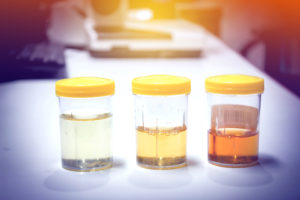
You don’t have to spend very long examining it to get an idea of where you might be. A glance and a couple of observations can tell you if you’re well-hydrated, need a drink, or might be looking at something more serious.
Normal urine color falls on a range from pale yellow to amber and is generally influenced by hydration. When you’re well-hydrated, it’s diluted. When you’re dehydrated, it’s concentrated and has a deep amber color. The yellow hue comes from a pigment called urochrome.
But there are several other colors along the spectrum. Sometimes they can be rather confusing or alarming. Let’s take a look at what you might see and what it could mean.
If your urine is consistently clear, you’re probably drinking too much water. Sounds weird, right? Too much water? But it’s true. When you’re constantly drinking and frequently urinating, you might be getting rid of valuable electrolytes your body needs.
The light-yellow color is the sweet spot.
Sometimes you might notice your pee is bright green. If it is, consider the supplements you’re taking. Some supplements, particularly fat-soluble ones like vitamins A, D, E, and K, can lead to neon green pee. It’s really nothing to worry about if you’re taking recommended dosages.
In some cases, however, a light green or blue pee can indicate a urinary tract infection (UTI). If you haven’t taken any supplements, medications, or eaten food dyed those colors, it’s wise to alert your physician.
Dark orange or brown urine can also indicate a problem. If you’re not severely dehydrated, these colors can indicate a potential liver trouble. Pale stool and a yellow tinge to the skin and eyes would be concurrent symptoms to look for.
Also, if you’ve gone against public health officials and taken the anti-malarial drug hydroxychloroquine to try and limit your risk for COVID-19, you may experience dark brown urine.
Urine might also be red or pink, which can be quite alarming. Sometimes, however, it is nothing to worry about. Certain foods like beets, berries, and rhubarb can turn your pee red. If it’s one or two pees not long after eating these foods, you’re all good.
Sometimes, however, that red can be blood. If it is, it could suggest a UTI, enlarged prostate, kidney cyst, kidney stone, or bladder issues.
Cloudy pee can suggest a UTI or kidney stone, so be on the lookout for that.
In most cases, staying hydrated will help promote healthy urine and a healthy bladder. Emptying your bladder regularly and working to achieve a light yellow hue in your urine can help prevent infection and showcase adequate hydration.
If you’re staying hydrated and notice unexplainable, consistent changes to urine color, contact your doctor or urologist immediately.